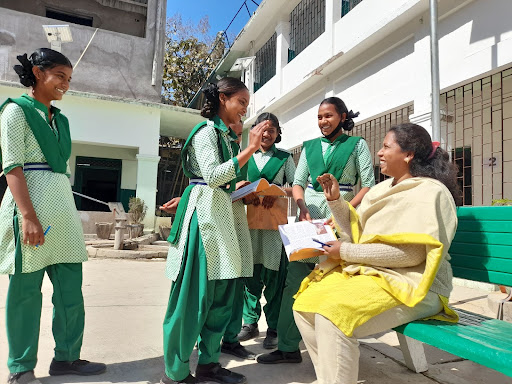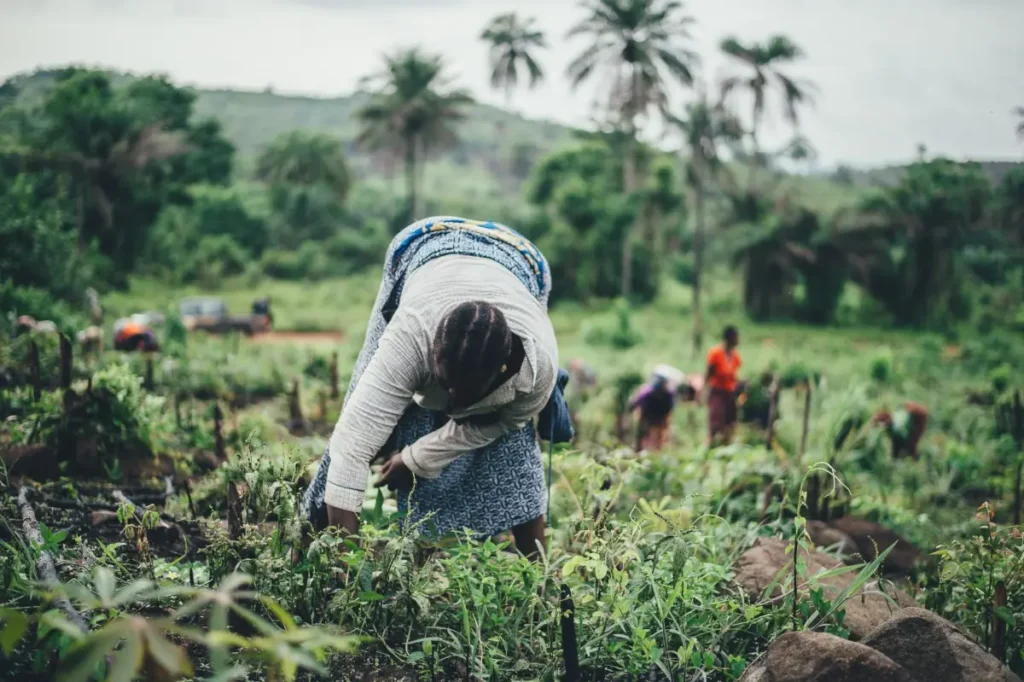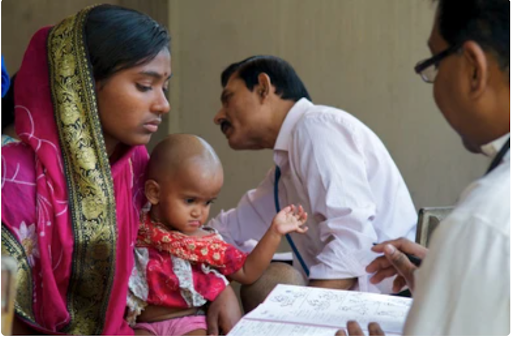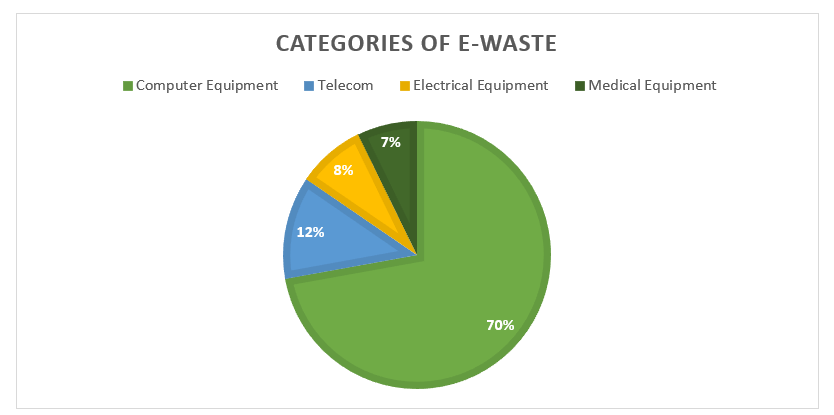The Whole Child Development (WCD) approach recognises that students’ education and life outcomes are dependent on their access to safe learning environments in school and beyond it. In practice, this involves implementing socio-emotional learning (SEL) and equipping children with competencies such as responsible decision making, empathy, self-management, self-awareness, social-awareness – which enables them to solve problems, overcome negative experiences and build positive relationships.
WCD is highly relevant in the Indian context where 250+ million adolescents hold the power to shape country’s future – but a large proportion experience adversities (climate disaster, poverty, poor health, child marriage) that hinder their ability to grow and thrive into adulthood.
The Central Government has recognised the value of WCD and instituted policies (NEP 2020) and initiatives promoting integration of socio-emotional learning into curriculum and practice. Yet a disproportionate focus on learning outcomes and systemic issues of capability and processes has diffused WCD implementation efforts.
CLIENT BRIEF
Project Sampoorna is the result of recognising that systems change towards embedding WCD practices cannot be achieved in isolation, the formation of a consortium became imperative.
The Sampoorna Consortium is strengthening access to quality education by introducing Social Emotional Learning into curriculums and enabling efficient adult support systems. It is specifically designed to address the multifaceted challenges faced by adolescents belonging to ethnic communities, backward and scheduled castes – which encompass issues such as poverty, abuse, neglect, violence, and discrimination. The project, therefore, adopts a holistic approach to account for the various components of this complex landscape. To this end, Sampoorna works with parents, teachers, and officials to refine processes, develop expertise, curriculum, assessment methodologies and institutions.
SATTVA’S APPROACH
Since 2019, Sattva’s Foundations team has led the design and management of Project Sampoorna. Over the years, the programme has evolved significantly in terms of the design and partners owing to the lessons from implementation as well as COVID-19.
In light of this, Sattva’s work is now anchored around five tracks:
- Operational rhythm and programme monitoring: Driving ownership of programme activities among partners to ensure seamless operations and monitoring the programme to ensure fidelity to programme design and evidence from the field.
- Strategic planning and support: Facilitating alignment of the programme basis learnings from pilot and problem-solving to achieve the north star of Sampoorna.
- Learning community: Inculcating a culture of learning within the consortium by creating a shared understanding of each organisations WCD narrative, bolstering communication from field implementation, and encouraging adoption of feedback mechanisms.
- Operational support: Integrating partners beyond implementation organisations to deliver desired outcomes.
- Ecosystem engagement: Undertaking narrative building and dissemination at multiple forums, including state government meetings, to amplify Sampoora’s work, influence dialogue on SEL and WCD and expand the community of interest in relevant states.
PEOPLE and EXPERTISE
The conceptualisation of this initiative was led by Rathish Balakrishnan, Co-Founder and Managing Partner at Sattva, with the strong support of a team that held expertise in the fields of education, government engagement and programme design and management.
RESPONDENT PROFILE
- Geography covered: Jharkhand
- Sample Size/Scale: 1 million students, 40,000 parents,18,000 teachers, 4500 principals and 550 officials in the state of Jharkhand.
The project is presently operating in 121 schools equipping 18,194 students, 242 teachers, 101 HMs, 5,431 officials and 14,974 parents with SEL competencies. - Relevant demographic markers: The programme accounts for diverse demographic factors such as age, gender, tribal/PWD/underserved community
- Factoring Adversities: The project design makes a conscious effort to factor in several multidimensional challenges faced by adolescents such as exclusion due to poverty, gender, caste, and tribe.
- Factoring Diversity: SEL curriculum and student activity booklet incorporate an inclusion lens where context, practices and different backgrounds of the students are factored in as part of the language used, stories as well as prompts for discussion
- Partners: The consortium has 6 partners with demonstrated expertise in developing happiness curricula, enabling agency of adolescents and large-scale assessments in India and abroad. This allows each partner to focus on one area of work, ensure quality and benefit from cross-learning.
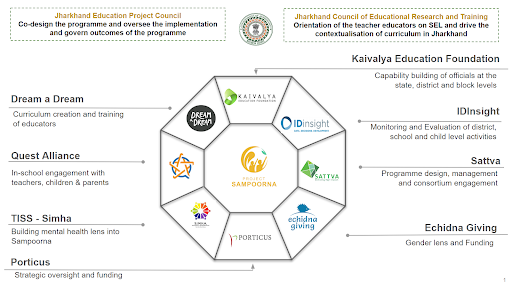
Sampoorna was first implemented in 60 residential government schools in 2019, and has since expanded to reach 121 schools, as of 2021. The programme has been instrumental in integrating SEL into state systems, which has resulted in SEL modules being a part of teacher training programmes and WCD being brought to the forefront of the education dialogue in Jharkhand.
Looking forward, the programme is set to soon be present in another 325 schools in the state.
KEY TAKEAWAYS
- A dedicated focus on sustained engagement with external stakeholders is vital, through outreach and individual interactions with critical stakeholders
- Multiple approaches are required to strengthen government engagement, including regular interactions with the State Programme Officer, collaboration with bodies such as Policy & Development Advisory Group, involvement in narrative building, etc.
- With regard to the Harsh Johar Curriculum, there is a need to create momentum within schools and districts, to ensure that teachers and officials beyond Sampoorna are also aware of the initiative
- It is important to rigorously capture experiences along with data for internal reporting, analysis and external communication.
PROJECT DELIVERABLES
Project Sampoorna is transforming the education system by building capacities and institutionalising processes to embed SEL in Jharkhand’s education system. At the school level, Sampoorna has revitalised classroom teaching, where children are now displaying a keen interest in the classroom, along with active participation.
-
The Jharkhand government invited Sampoorna to partner with the CM-led Adarsh Vidyalaya Programme (AVP). AVP is the state’s flagship programme which aims to create model/lighthouse schools in the state. Interventions were deployed to 121 schools and steps are being taken to build the system’s capacities to scale it to all 4500 Adarsh Vidyalaya.
-
Project Sampoorna has been able to leverage the school health and wellness programme (SHWP), a national initiative, to lay the foundations for SEL orientation and engagement across stakeholders.
-
It has supported the Government in rolling out School Health and Wellness Programme (SHWP) across all 19 aspirational districts. As part of this,
-
3 SEL modules were included in SHWP curriculum
-
SRD/DRG were trained to deliver the modules
-
30,000 teachers are being trained by SRGs and DRGs
-
Sampoorna is currently working towards amplifying evidence of SEL initiatives to ensure the education department invests in SEL initiatives in the coming years, for sustainable impact
-
Sampoorna has been invited by the state government to be part of a committee on future-oriented education research to bring the lens of SEL and WCD in the state’s overall education strategy
-
Prerna Circle, a discussion forum has been instituted by the consortium to facilitate meaningful engagement and learning among its members and with key external stakeholders working on WCD. Since its inception in 2021, 5 Prerna circles have been conducted, with 9 expert organisations.
-
Sampoorna was part of organising the ‘State of Adolescents in Jharkhand’ event in May 2021, where 15+ civil society organisations, government representatives, educators, learners and sector practitioners came together in Ranchi to share insights, learnings, and discuss opportunities to strengthen education, health and skill-building programmes for Jharkhand’s adolescents.
IMPACT
The Sampoorna consortium consists of 6 partners, led by Sattva – the Programme Management Unit. In this position, it is imperative that Sattva effectively represents the interests of all consortium members, while also ensuring the smooth functioning of other operations. Simultaneously, Sattva often serves as a problem solver and facilitator, providing a strategic way forward when required and ensuring collaborative yet agile decision making.
This programme is designed to have a child-level and society-level impact, with the aim of directly impacting 1 million students, 40,000 parents,18,000 teachers, 4500 principals and 550 officials in Jharkhand. Sampoorna is currently operating in 121 schools, where it is equipping 18,194 students, 242 teachers, 101 headteachers, 5,431 officials and 14,974 parents with SEL competencies.
The strengths of Sampoorna’s operational design and the advantages of partnering with a consortium have been recognised by the State Government, owing to which, it has recommended the best practices of Sampoorna to the Foundational Literacy and Numeracy (FLN) consortium in the state.
VOICES FROM THE GROUND
- “Social emotional learning has helped us stay calm and mindful even during the uncertainty of the pandemic”– Student in 10th grade in KGBV, Pulamu
- “There is more to growth of children than academics, we need to be more sensitive to support them in and outside classroom” – Teacher from Giridih
